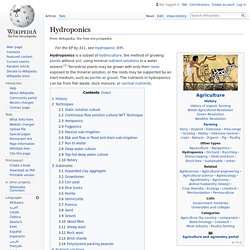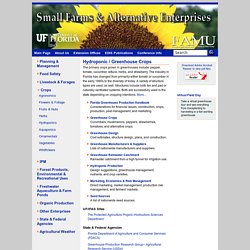

Hydroponics. NASA researcher checking hydroponic onions with Bibb lettuce to his left and radishes to the right Hydroponics is a subset of hydroculture, the method of growing plants without soil, using mineral nutrient solutions in a water solvent.[1] Terrestrial plants may be grown with only their roots exposed to the mineral solution, or the roots may be supported by an inert medium, such as perlite or gravel.

The nutrients in hydroponics can be from fish waste, duck manure, or normal nutrients. History[edit] In 1929, William Frederick Gericke of the University of California at Berkeley began publicly promoting that solution culture be used for agricultural crop production.[3][4] He first termed it aquaculture but later found that aquaculture was already applied to culture of aquatic organisms. Reports of Gericke's work and his claims that hydroponics would revolutionize plant agriculture prompted a huge number of requests for further information. Techniques[edit] Static solution culture[edit] Hydroponic Research - Lincoln University. Floating_Hydroponics Greenhouse. A hydroponic lettuce demonstration greenhouse operation More pictures Address: 10 Pinckney Road Ithaca, NY 14850 U.S.A.
Currently operated by Challenge Industries, Inc., Ithaca NY. Please visit the web site of the lettuce greenhouse at Introduction Cornell University's Controlled Environment Agriculture (CEA) Program has been involved in greenhouse hydroponic vegetable production research since 1991. Funding for the research and construction of the hydroponic lettuce demonstration facility was provided by: Background In the Northeastern United States, year-round and rapid production is only possible with accurate greenhouse climate control, including the integration of supplemental lighting and carbon dioxide enrichment of the greenhouse air. Two hydroponic growing systems have been utilized during the research: the nutrient film technique (NFT) and floating hydroponics (FH). Labor Two full-time and one part-time greenhouse grower are employed at the demonstration facility.
Future Plans. Growing Hydroponic Tomatoes Home Page. This interactive web site provides practical, accurate information on growing hydroponic tomatoes for students, hobbyists, and beginning growers.

Hydroponic culture is one of the most exacting and intensive methods of crop production used in agriculture today. Over the last 20 years, great advances in hydroponic technology have been made through extensive research and development programs in the United States and Europe. And although hydroponics may be technology and capital intensive, it is also extremely productive and efficient in its water and land use. Whether your interest in hydroponics is as a hobby, an additional source of income, or you want to get into the commercial market, the future and opportunities in soilless culture are more favorable today than ever before. We hope this introduction to hydroponic tomato growing will spark your interest, provide information, and lead you other resources available in print and on the web. Hydroponic / Greenhouse Crops - Small Farms / Alternative Enterprises - Institute of Food and Agricultural Sciences Extension. The primary crops grown in greenhouses include: pepper, tomato, cucumber, lettuce, herbs, and strawberry.

The industry in Florida has changed from primarily either tomato or cucumber in the early 1990s to the diversity of today. A variety of structure types are used, as well. Structures include both fan and pad or naturally ventilated systems. Both are successfully used in the state depending on cropping intentions. More... Florida Greenhouse Production Handbook Considerations for financial issues, construction, crops, production, pest management, and marketing. UF/IFAS Sites The Protected Agriculture Project--Horticulture Sciences Department State & Federal Agencies Other University Sites Organization & Associations Return to top Return to Crops.